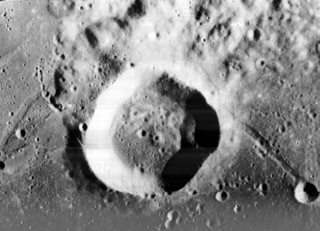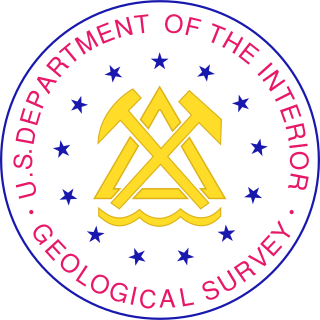
Appleton is a heavily eroded lunar impact crater that lies in the northern hemisphere on the far side of the Moon. To the northwest are the craters Von Neumann and Campbel. The smaller Golovin lies to the northeast, while further to the southwest is the Mare Moscoviense.

Baillaud is a lunar impact crater that is located near the north limb of the Moon. The rim of the crater has been eroded and worn by a long history of impacts, leaving a hilly ridge surrounding the interior. The crater Euctemon is intruding into the rim to the northeast, and the rim bulges outward to the northwest. At the south end of the crater is a gap connecting to the lava-flooded surface to the south.

Byrd is an irregular lunar impact crater that is located near the north pole of the Moon. The north rim of Byrd is nearly connected to the crater Peary, a formation that is adjacent to the pole. The smaller crater Gioja is attached to the remains of the southwest rim.

Blanchinus is a lunar impact crater that is situated in the rugged south-central highlands of the Moon. The crater is named after Italian astronomer Giovanni Bianchini whose Latinized name is Blanchinus. Adjacent to the south of Blanchinus is the crater Werner, and La Caille is attached to the northwest rim. West of the crater is the prominent formation Purbach.

Boyle is a lunar impact crater that is located in the southern hemisphere on the rugged far side of the Moon. It is adjacent to the larger crater Hess to the southeast, and lies about midway between the craters Alder to the north-northeast and Abbe to the south-southwest.

Fizeau is a prominent lunar impact crater that is located on the far side of the Moon, in the southern hemisphere. Nearby craters of note include Minkowski to the west-northwest, and Eijkman to the southwest.

Biela is a lunar impact crater that is located in the rugged highlands of the southeastern Moon. It is named after Austrian astronomer Wilhelm von Biela. The crater lies to the east of Rosenberger, to the southeast of the Watt–Steinheil double crater.
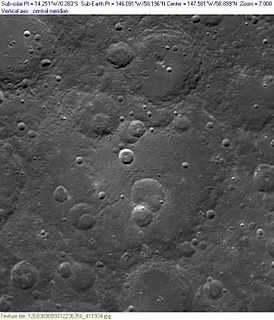
Birkhoff is a giant lunar walled plain that is located on the far side of the Moon, in the northern hemisphere. This formation is an ancient impact site that has been heavily eroded, and the surface reshaped by multiple craters in the interior and along the rim. The outer wall is bordered by the craters Carnot to the south, Rowland along the west rim, and Stebbins to the north. Just to the northeast is van't Hoff.

Berzelius is a lunar impact crater located in the northeast part of the Moon's near side. It lies to the southeast of the crater Franklin, and to the northwest of Geminus.
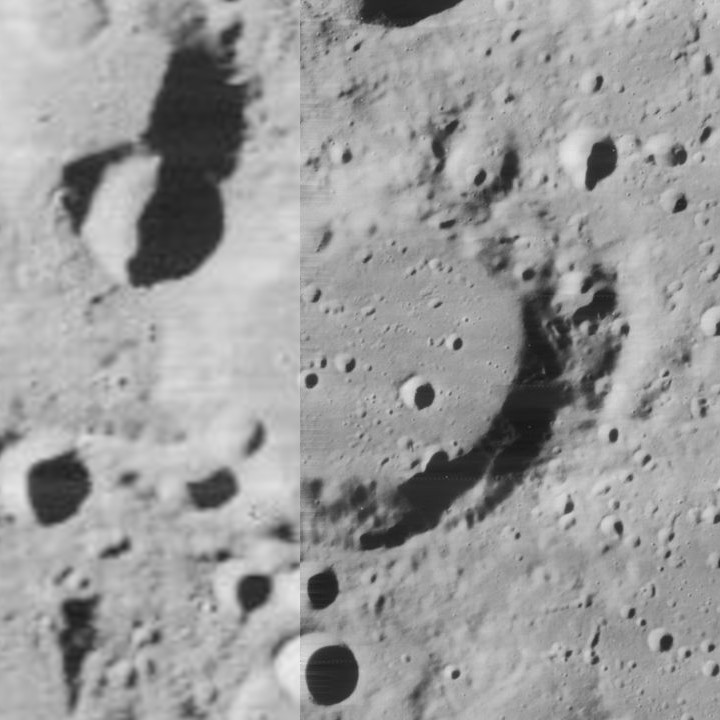
Cleostratus is a lunar impact crater near the northwest limb of the Moon. It lies to the northeast of the crater Xenophanes, and west-southwest of the prominent Pythagoras. From the Earth this crater appears highly elongated due to foreshortening.

Cannizzaro is a lunar impact crater that is located on the Moon's far side as seen from the Earth, just beyond the northwestern limb. It lies in a region of the surface that is sometimes brought into view due to the effects of libration, but not much detail can be seen since this feature is viewed from the side. The crater lies across the southwestern rim of the much larger-walled plain Poczobutt.

Carnot is a large crater in the northern part of the Moon's far side. It intrudes into the southern rim of the huge walled plain Birkhoff. To the west-southwest of Carnot is the crater Paraskevopoulos.

Chappell is a lunar impact crater that is located on the far side of the Moon, in the northern hemisphere just to the north of the crater Debye. This feature is located in a heavily bombarded section of the surface, and much of the outer rim of the crater is overlain by many smaller craters. The northern rim in particular has been almost completely disintegrated, while small craters also overlie the rim to the northwest and southeast. What remains of the rim forms a rounded, somewhat irregular edge to the crater depression.

Donner is a lunar impact crater on the far side of the Moon. It is located just to the northeast of the Mare Australe, behind the southeastern limb of the Moon. During favorable librations this part of the lunar surface can be brought into view of the Earth, but the site is viewed from the edge and so not much detail can be seen.

Dreyer is the remnant of a lunar impact crater on the far side of the Moon. It is located along the eastern edge of the Mare Marginis, about midway between the craters Ginzel to the north and Erro to the south-southeast. It was named after Danish-Irish astronomer John L. E. Dreyer.

Evershed is a lunar impact crater on the far side of the Moon, named after the English solar astronomer John Evershed. It is located to the northeast of the larger crater Cockcroft, and to the north of the smaller Van den Bergh.

Hippocrates is a lunar impact crater on the far side of the Moon. It is located in the northern region of the lunar surface, to the north of the crater Stebbins. To the southwest of Hippocrates are Kirkwood and the large Sommerfeld.
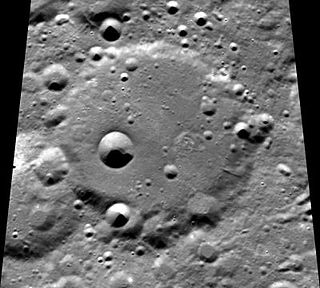
Mezentsev is a lunar impact crater that is located in the high northern latitudes on the Moon's far side. It lies just to the west of the smaller Niepce. To the southwest is the larger Stebbins, to the west-southwest is Hippocrates and to the northwest is Heymans.

Levi-Civita is a lunar impact crater formation that lies on the far side of the Moon. It was named after Italian mathematician Tullio Levi-Civita. It is located just to the southwest of the large walled plain Gagarin, and nearly as close to the crater Pavlov to the south-southwest. To the northwest of Levi-Civita lies the smaller crater Pirquet.

van 't Hoff is a lunar impact crater named after Dutch chemist Jacobus H. van 't Hoff and is located to the northeast of the walled plain Birkhoff, on the far side of the Moon. To the northwest is the crater Stebbins, and to the east lies the smaller Dyson.


